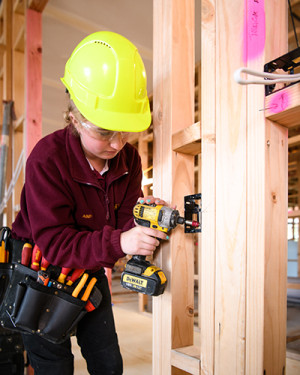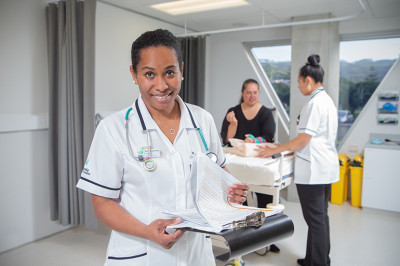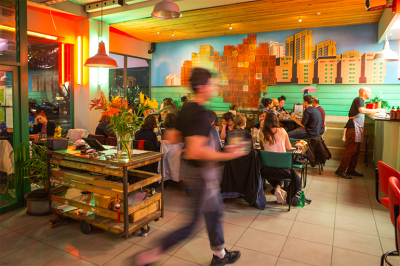Regional workforce outlook for our priority sectors
This is an update on labour supply and demand in our region. It provides a workforce outlook for the RWP priority sectors: construction and infrastructure, manufacturing, health (kaiāwhina to nursing) digital technology, primary sector, and the visitor sector. This analysis informed our advice to the Tertiary Education Commission (TEC) to help focus their 2024 funding decisions.
 Construction and Infrastructure
Construction and Infrastructure
Wellington’s construction and infrastructure sector continues to grow with approximately 3,000 job openings expected between 2025 and 2028[5]. For some areas of construction, particularly for plumbers, gasfitters and drainlayers, the changes in the vocational education system are being felt. There are delayed apprentice completions, increased costs, insufficient block courses and on-site verification. This is as we experience acute shortages in supply and plumbers are added to the immigration Construction and Infrastructure Skill Shortage List.
Work is beginning on several major housing and infrastructure developments including a very large housing development in Porirua East (Kāinga Ora), the RiverLink building and roading project in Lower Hutt, Wellington Water projects, aged residential care and housing developments in Kāpiti, the Ōtaki – Levin highway extension, and earthquake strengthening. In Wairarapa, skilled labour is needed for housing developments, Matua Pā and an iwi-owned energy initiative.
There is an important opportunity for skills development and employment for Māori and Pacific peoples in communities with construction and infrastructure developments. Broader outcomes are included in associated procurements to leverage these opportunities. Local Jobs and Skills Hubs have been established in Porirua East and Hutt Valley to build supply by recruiting and developing the local workforce.
There is a growing need for highly skilled professionals who can apply new and emerging technologies to drive productivity gains such as information modelling for buildings created in the Cloud.
Manufacturing
There is demand for welders, fabricators, and associated staff such as detailers, computerised drawing experts, supervisors, project managers, quantity surveyors and estimators. Local employers are relying on skilled migrants to fill immediate shortages at all levels, and on outsourcing to third parties in other regions. Demand will remain strong to service and supply the construction and infrastructure projects in the region. Approximately 3,000 job openings are expected between 2025 and 2028, with the greatest number expected in Food Product Manufacturing (29% of forecast job openings) and Fabricated Metal Product Manufacturing (14% of forecast job openings)[6].
Robotics and automation are areas of emerging growth. Local manufacturers are preparing for ‘the fourth industrial revolution’ (Industry 4.0), by undertaking audits of their manufacturing processes. This highlights the opportunities to harness converging technologies (data collection, communications technologies, robotics) to lift productivity. This is set to drive the uptake of new technologies with a move away from manual to digital operations.
Unlocking your Industry 4.0 potential(external link) — Industry 4.0

Health (Kaiāwhina to nursing)
Image: courtesy of Te Pūkenga | Whitireia WelTec
The RWP is focused on kaiāwhina pathways and progression to other roles, including nursing. Approximately 11,000 people are employed in the region as ‘Health and Welfare Support Workers’ or ‘Personal Carers and Assistants’. This workforce is forecast to grow by around 1,000 people by 2028[7].
During the Covid response, iwi and Māori health providers rapidly established teams of kaiāwhina health and welfare support workers with Māori and Pacific peoples making up most of this workforce. These roles contributed to pro-equity outcomes and provided positive experiences for whānau and communities. Now there is an opportunity to do more to grow and support opportunities for Māori and Pacific peoples in the region’s health workforce. This requires investment in training that values Māori approaches to health, that is locally accessible and includes ‘earn as you learn’ options and builds the cultural capability of the workforce to be more inclusive of diverse perspectives in healthcare.
Currently an estimated 7,200[8] people are employed as nursing professionals in Wellington region, including nurse managers.
 Digital Technologies Sector
Digital Technologies Sector
Wellington’s digital technologies sector is focused on digital products, services or solutions, such as data processing services, computer system design and software publishing, in screen (post-production and digital workshops) interactive media and gaming, financial and health technology, digital technology for agriculture, artificial intelligence and Software as a Service (SaaS). It is a high value, high growth sector of the regional economy. People with advanced digital skills are also widely employed outside the digital technologies sector. It is estimated that 17,000[9] people are employed in digital technology businesses across the region, mostly in Wellington city and Hutt Valley. Wellington city is a centre of excellence in the sector with 6% employment compared with a national average of 1.69%[10]. Currently there are significant shortages of people with advanced digital skills to meet regional demand. The region immediately needs more people with skills in coding, web design, software development, end to end web development, programming languages and software development platforms, data analysis, user experience and design, content management, cloud computing and cloud-based solutions.
Skills are also required to integrate developments in augmented and virtual reality, artificial intelligence, block chain machine learning, and the Internet of Things (IoT) into an array of applications. Cybersecurity professionals are needed to secure digital systems and networks and integrate best security practices into development processes and applications. The region’s digital professionals also need awareness of Māori data sovereignty and the ability to apply this in their work.
There is a lack of diversity in the sector with Māori, Pacific peoples and women under-represented. From a Māori perspective this lack of diversity limits the development of culturally responsive technologies.
To build the capability and capacity of companies to innovate and adapt to changing trends, the industry needs people with ‘soft skills’, such as communication, problem-solving, teamwork, cultural competence and creative thinking.
Primary Sector
The primary sector has been identified in the Wellington Regional Economic Development Plan[11] as an area of economic growth. It is largely land-based and located in Wairarapa with primary production also in Kāpiti and Upper Hutt. It is characterised by red meat and wool, dairy, and arable farming plus horticulture, viticulture, apiculture, and forestry. Agricultural contracting services are also important in the region’s primary sector.
Emerging trends are sustainable land management[12] and practices that draw on mātauranga Māori and adaption to climate change[13]. Many large properties are also being sold for forestry and carbon harvesting, and potentially long-term horticulture. These changes may be accompanied by an increase in farm advisory roles.
The sector is currently experiencing skilled labour shortages. To encourage recruitment, investment is needed in pathways from school to work and in the pipeline from farm assistant to farm manager. Practical foundation skills, such as fencing, calf-rearing, chainsaw operation, planting and pruning, quad bike operation and health and safety are required for the primary sector.
 Visitor Sector
Visitor Sector
The RWP focus is on the hospitality, food, and accommodation sector. It is strategically important in all parts of our region and there are destination management plans in place across our five sub-regions that emphasise the importance of hospitality.
Local developments are expected to increase demand for skilled labour. For example: Tākina Wellington Convention and Exhibition sector, Lane Street Studios, Te Wānanga Taiao projects in Wairarapa, Porirua Adventure Park, and the Kāpiti Food and Beverage Cluster.
Skilled labour is a challenge to meet both current and future demand in all parts of the sector with a notable shortage of qualified chefs. The number of forecast job openings in accommodation and food services is approximately 6,000 between 2025-2028[14]. The impact of Covid 19 on the hospitality sector is significant and full recovery will take some time. The Better Work Action Plan, a component of the Tourism Industry Transformation Plan, contains actions to meet some of these challenges and improve recruitment and retention of staff.
Footnotes
[5] Infometrics ‘Industry Employment’ projections for the Wellington region ANZSIC L1, Construction, Electricity, Gas Water and Waste Services
[6] Infometrics Industry Employment Projections for the Wellington Region Manufacturing ANZSIC Level 2
[7] Infometrics projections for the Wellington region by occupation (ANZSCO Level 3) accessed 24 February 2023
[8] Infometrics projections for the Wellington region by occupation (ANZSCO Level 3) accessed 24 February 2023
[9] Infometrics 2024 Occupation Employment projections for ANZSCO Level 3 and Level 4
[10] Draft Digital Technologies Industry Transformation Plan [PDF, 2.16MB](external link)
[11] Wellington Regional Economic Development Plan(external link) pp 36-40; the scope of the plan includes food processing
[12] See the Wellington Regional Economic Development Plan(external link)
[13] See the Wairarapa Economic Development Strategy(external link) - Land Use Focus
[14] Infometrics 2025-2028 Industry Job Openings Projections for the Wellington Region for ANZSIC Level 1 ’Accommodation and Food Services’.

